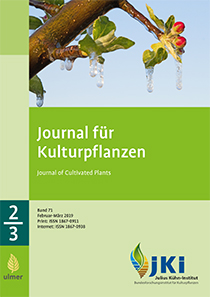Effects of different tillage systems on yields and soil properties at test site Gülzow (Mecklenburg-Western Pomerania)
DOI:
https://doi.org/10.5073/JfK.2019.02-03.02Keywords:
agriculture, compaction, plough, grubber, penetration resistanceAbstract
In a long-term tillage experiment in Mecklenburg-Western Pomerania high penetration resistances up to 3,5 MPa were found in 30–45 cm soil depth as a result of continuous ploughing. A no-till-system showed a gradual increase over 0–60 cm soil depth. Tillage with plough, cultivator or rotational tillage (changing of plough and cultivator) caused different effects on dry density, porosity, water and air content in the upper soil (0–30 cm). Under the existing site conditions, yields were not compromised by a reduction of the tillage intensity. The data suggest that rotational tillage may have beneficial effects on physical soil properties, similar to the effects observed with continuous no-till regimes.
DOI: 10.5073/JfK.2019.02-03.02, https://doi.org/10.5073/JfK.2019.02-03.02
Downloads
Published
Issue
Section
License
The content of the journal is licensed under the Creative Commons Attribution 4.0 License. Any user is free to share and adapt (remix, transform, build upon) the content as long as the original publication is attributed (authors, title, year, journal, issue, pages).
The copyright of the published work remains with the authors. The authors grant the Journal of Cultivated Plants, the Julius Kühn-Institut and the OpenAgrar repository the non-exclusive right to distribute and exploit the work.







